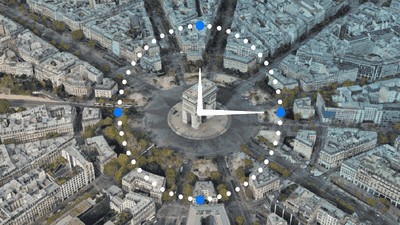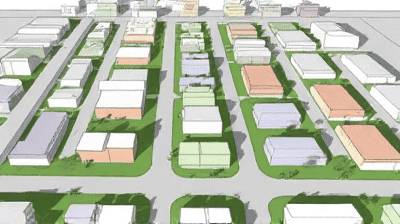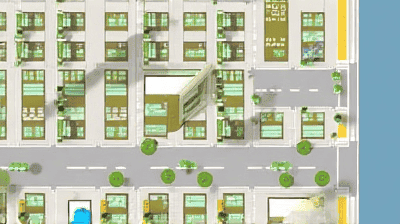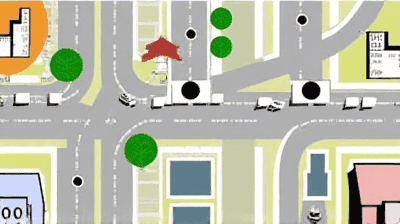
As urban populations continue to swell, cities around the globe are grappling with the challenges of congestion, pollution, and energy consumption associated with car dependency. In response to these challenges, the 15-minute city concept has emerged as an innovative urban planning model aimed at creating more livable, sustainable environments.
The 15-minute city is an urban planning concept that envisions a city where residents can meet most of their daily needs within a 15-minute walk or bike ride from their homes. This model emphasizes the proximity of essential services—such as work, education, healthcare, recreation, and retail—within easily accessible distances. The idea is to transform urban spaces into integrated, multifunctional areas where transportation is less reliant on cars and more focused on walking, cycling, and public transport.
Mixed-Use Development: Combining residential, commercial, and recreational spaces to create vibrant neighborhoods where people can live, work, and play.
Pedestrian-Centric Infrastructure: Prioritizing safe and accessible pathways, sidewalks, and bike lanes that encourage walking and cycling.
Access to Public Transit: Enhancing public transportation networks to connect communities and provide efficient alternatives to car travel.
Community Spaces: Creating parks, plazas, and other communal areas that foster social interaction and community engagement.
Sustainable Practices: Encouraging green building practices, renewable energy use, and waste reduction in urban design.
The 15-minute city concept isn't entirely new; variations of it have existed throughout history. Many towns and cities, particularly before the widespread adoption of automobiles, exhibited characteristics of the 15-minute city, where basic amenities were readily available within walking distance.
In recent years, thought leaders such as Carlos Moreno, an urban planner and researcher, have revived and refined this idea, advocating for a shift in urban design to create cities that prioritize human interaction, sustainability, and well-being over car dependency.

Air Pollution: Vehicle emissions contribute to high levels of air pollution, negatively impacting public health and contributing to conditions such as asthma and cardiovascular disease.
Greenhouse Gas Emissions: Transportation is a significant source of greenhouse gas emissions, which contribute to climate change. Reducing car dependency is essential to meet climate targets and mitigate the effects of global warming.
Urban Heat Islands: Car-centric urban planning often leads to increased impervious surfaces and heat generation, exacerbating the urban heat island effect and increasing energy demand for cooling.
Inequitable Access: In car-dependent cities, individuals without access to vehicles face challenges in accessing essential services, leading to social isolation and economic disadvantage.
Decreased Quality of Life: High levels of traffic congestion negatively impact quality of life by increasing travel time, stress, and reducing opportunities for social interaction.
Public Health Risks: Sedentary lifestyles associated with car dependency contribute to various health problems, including obesity, cardiovascular disease, and mental health issues.
Infrastructure Costs: Cities often face high costs for road maintenance, traffic control systems, and infrastructure dedicated to automobile use, diverting funds away from public transit and community development.
Loss of Local Business: When neighborhoods are designed exclusively for cars, local businesses may suffer, as consumers are less likely to walk or bike to shop.
Reduced Property Values: Areas dominated by traffic are often perceived as less desirable, leading to lower property values and a reduced tax base.
The 15-minute city model offers actionable solutions to mitigate the challenges associated with car dependency. By fostering a built environment where essential services are nearby and accessible, this concept can significantly transform urban living and promote sustainable transport methods.
A cornerstone of the 15-minute city is creating walkable environments. Walkability encourages residents to choose walking for short trips, reducing reliance on cars. Key strategies include:
Pedestrian-Friendly Streets: Designing streets with sidewalks, pedestrian crossings, and traffic calming measures ensures safe and pleasant walking experiences.
Mixed-Use Developments: By incorporating retail, offices, and recreational areas within residential neighborhoods, residents can access goods and services without the need for a car.
Cycling is an efficient, healthy mode of transportation that can replace short car trips. Strategies to promote cycling in the 15-minute city include:
Dedicated Bike Lanes: Implementing safe and well-maintained cycling infrastructure encourages residents to choose bicycles over cars.
Bike-Sharing Programs: Establishing bike-sharing initiatives makes it easy for residents to access bicycles on-demand, further promoting cycling within the community.
In the 15-minute city, public transportation options are integral to reducing car dependency. Strategies include:
Transit-Oriented Development: Creating developments centered around public transit stations encourages residents to rely on public transportation.
Frequent, Reliable Services: Ensuring that public transit services are frequent, reliable, and affordable makes them a practical alternative to driving.
By designing vibrant, multifunctional spaces, the 15-minute city encourages social interaction and a sense of community. Key strategies include:
Community Spaces: Parks, plazas, and community gardens provide spaces for social gathering, fostering connections among residents.
Cultural and Recreational Facilities: Including theaters, museums, and recreational centers in neighborhoods enhances community cohesion and promotes active lifestyles.
Green spaces are essential for promoting environmental health, physical well-being, and community interaction. The 15-minute city emphasizes:
Urban Parks and Green Corridors: Creating interconnected green spaces encourages outdoor activities, reduces urban heat, and provides habitats for wildlife.
Community Gardens: Integrating gardens within neighborhoods supports local food production while engaging residents in sustainable practices.

The reduction of car dependency is a critical step toward lowering greenhouse gas emissions and improving air quality. The 15-minute city promotes sustainable practices by:
Encouraging Active Transportation: Walking and cycling generate no emissions, thus contributing to cleaner air and reduced congestion.
Supporting Public Transit: Enhanced public transportation options lead to fewer cars on the road, reducing traffic congestion and associated emissions.
Green Infrastructure: Urban green spaces contribute to biodiversity, habitat preservation, and climate change mitigation by absorbing carbon and managing stormwater.
Promoting physical activity and reducing pollution contribute to improved public health outcomes in the 15-minute city. Key benefits include:
Active Lifestyles: With walking and cycling integrated into daily life, residents can maintain healthier lifestyles, reducing the risk of obesity and related health conditions.
Improved Mental Health: Access to green spaces and community interactions can enhance mental well-being, reducing stress and promoting feelings of belonging.
Reduced Air Pollution: By decreasing vehicle emissions, cities can enhance air quality, leading to fewer respiratory illnesses and overall healthier populations.
The 15-minute city can stimulate local economies by enhancing accessibility and attracting businesses. Benefits include:
Increased Local Business Support: By promoting walkable environments where goods and services are easily accessible, local businesses benefit from increased foot traffic.
Higher Property Values: Walkable, vibrant neighborhoods are often more desirable, leading to increased property values and tax revenue for local governments.
Job Creation: Investments in public transport, green spaces, and local infrastructure generate jobs in construction, maintenance, and local services.
The 15-minute city fosters social equity by ensuring that residents have access to essential services and opportunities. Benefits include:
Equitable Access: Reducing car dependency ensures that all residents, regardless of income level, have access to essential services, enhancing equity.
Community Cohesion: By designing neighborhoods that prioritize social interaction, the 15-minute city promotes stronger community ties and resilience.
Several cities worldwide have begun implementing the principles of the 15-minute city, demonstrating practical applications and positive outcomes.
Paris is a global leader in adopting the 15-minute city concept, with Mayor Anne Hidalgo championing this model. Key initiatives include:
Neighborhood Transformations: The city has implemented policies to reduce car routes in several neighborhoods, transforming these areas into pedestrian-friendly spaces.
Expanded Bike Network: Paris has invested in expanding its cycling infrastructure, including dedicated bike lanes and a bike-sharing program called Velib, which has seen widespread adoption.
Community Spaces: The city has created numerous public parks and community spaces, enhancing accessibility and leisure opportunities for residents.
Melbourne has embraced the 15-minute city concept as a part of its urban planning agenda. Notable initiatives include:
10-Minute Neighborhoods: The city developed the concept of "10-minute neighborhoods," where essential services are accessible within a 10-minute walk.
Support for Active Living: Melbourne's urban design encourages walking and cycling through improved pathways, lighting, and shaded routes.
Community Engagement: The city has actively involved residents in the planning process, ensuring that community needs are met.
Bogotá has made significant strides in reducing car dependency through its initiatives focused on urban mobility and public transportation. Key strategies include:
Extensive BRT System: The city’s Bus Rapid Transit (BRT) system, known as TransMilenio, has improved public transport access and reduced reliance on personal vehicles.
Cycling Infrastructure: Bogotá has implemented a network of cycling lanes and designated days for ciclovía—temporary street closures that allow residents to bike and walk freely.
Public Spaces: The city has revamped numerous public spaces, promoting community interaction and enhancing mobility options.

While the benefits of the 15-minute city concept are clear, several challenges must be addressed during implementation:
Existing Zoning Laws: Many cities may have outdated zoning regulations that hinder mixed-use developments and pedestrian-friendly initiatives.
Funding Constraints: Limited budgets can restrict the implementation of new infrastructure projects necessary for creating a 15-minute city.
Cultural Attachment to Cars: In car-dependent societies, there may be resistance to change and skepticism about reducing car usage.
Concerns About Gentrification: There can be fears that improvements to neighborhoods could lead to displacement of lower-income residents.
Aging Infrastructure: Many cities face challenges in upgrading existing infrastructure to accommodate active transportation and enhance public transit systems.
Maintenance Needs: Ensuring the ongoing maintenance and safety of pedestrian and cycling infrastructure is essential for their sustained use.
The 15-minute city concept holds great potential for reshaping urban planning practices and creating sustainable environments. Future trends may include:
Technological advancements can enhance the implementation of the 15-minute city concept, supporting active transportation and community engagement. Examples include:
Smart City Solutions: Integrated technologies can optimize traffic flow, improve public transport schedules, and enhance safety measures.
Data-Driven Urban Planning: Utilizing data analytics can help planners understand commuter patterns, allowing for more efficient land use and infrastructure planning.
Policy reforms will be critical to supporting the 15-minute city model. Local governments may focus on:
Incentives for Sustainable Development: Offering tax incentives or grants for mixed-use developments can encourage sustainable urban growth.
Community Participation in Planning: Ensuring that residents have a voice in urban planning processes can enhance buy-in and support for projects that promote the 15-minute city concept.
The future of urban planning will likely embrace a holistic approach that integrates economic, social, and environmental sustainability:
Resource Management: Encouraging sustainable resource management practices, such as water conservation and energy efficiency, enhances the overall sustainability of urban areas.
Social Programs: Initiatives to support low-income residents can ensure equitable access to essential services and promote social cohesion.
The 15-minute city concept represents a transformative vision for sustainable urban living that prioritizes accessibility, community engagement, and reduced reliance on cars. Through focused urban planning and innovative strategies, cities can create environments where residents can meet their daily needs within a compact and interconnected framework.
As urban areas continue to address the challenges of congestion, pollution, and social inequity, adopting the principles of the 15-minute city could be key to shaping healthier, more equitable, and more sustainable futures. By fostering walkable neighborhoods, enhancing public transit, and encouraging alternative modes of transportation, cities can cultivate vibrant communities that improve quality of life for all residents.